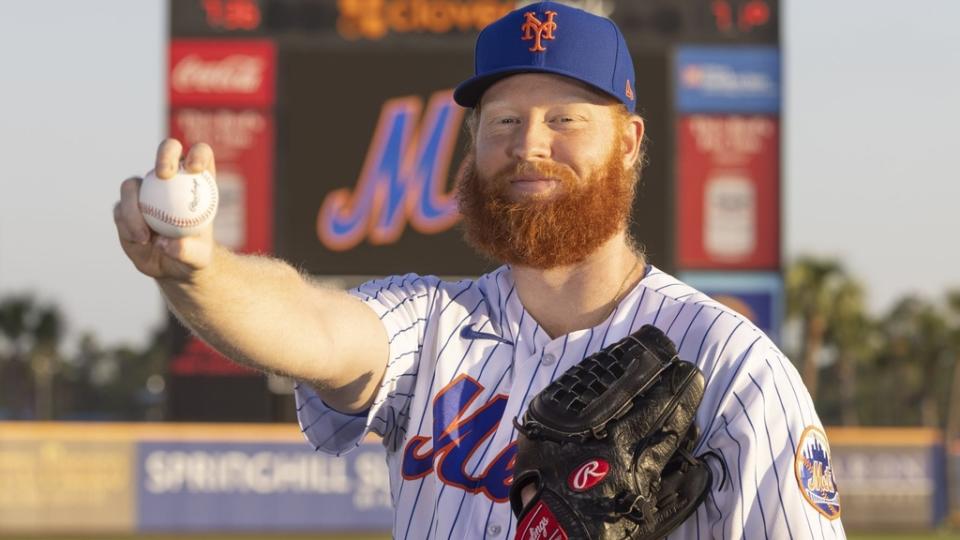
PORT ST. LUCIE — Stephen Ridings threw 100 mph in his major league debut as a Yankee reliever in August of 2021 and became something of an instant sensation with a great back story: a Long Island native who was forced to work as a substitute teacher and Rawlings Sporting Goods salesman to make ends meet meet during the COVID-19 pandemic.
However, injuries derailed the Disney movie in the making, leading the Yankees to put him on waivers in November of 2022.
And Billy Eppler swooped in to sign Ridings, gambling that the 6-foot-8 right-hander can stay healthy enough to make an impact in the Mets’ bullpen this season.
It wasn’t the only such gamble the Mets took this winter. In fact it was part of a specific strategy: after building the nucleus of the 2023 bullpen with key free-agent signings and a significant trade this winter, Eppler could have spent more of Steve Cohen‘s money for added depth on veteran relievers but instead decided to make several bets on high-ceiling, high-risk arms that have the potential for dominance.
“You want to take some shots,” was the way Eppler put it Wednesday when I asked him to explain his bullpen philosophy. “You start out needing a minimum of four, maybe five high-leverage relievers. After that you look for high-upside guys with certain level of tools — some element of velocity, secondary stuff or maybe a deception component.
“If you take maybe 10 of those shots and you hit on one or two of them, it’s worth it. Maybe you wind up with a sixth high-leverage guy, which really adds to the bullpen.”
In addition, Eppler thought it was critical to have at least a few relievers with minor-league options, giving the Mets the flexibility to send someone down and bring in a fresh arm when the bullpen gets overworked, an inevitability in this era when analytics dictate that starters are pulled earlier in games than ever.
“If you don’t have flexibility,” the GM explained, “you can’t make moves when you might need to, and you’re going to wear guys down physically.”

With that in mind, with their high-leverage group of Edwin Diaz, Adam Ottavino, David Robertson, Brooks Raley and Drew Smith instead, the Mets passed on some proven relievers who were still available deep into the offseason such as lefty Andrew Chaffin and right-hander Michael Fulmer.
Instead, they’re hoping to hit on some of Eppler’s “shots,” though the reality of such gambles hit home Wednesday when Sam Coonroda hard-throwing right-hander who had impressed the Mets this spring, was lost for what is likely to be several weeks with a high-grade lat strain.
“He was having a great spring,” he said Buck Showalter. “He was pitching as well as anybody in camp.”
Of course, Coonrod was a Met only because the Philadelphia Phillies released him after an injury-plagued 2022 season.
And because the Mets’ own emerging prospect, Bryce Montes de Ocaalso went down this week due to a stress reaction in his right elbow, the competition for the non high-leverage bullpen spots is thinning out.
A veteran Tommy Hunter and Stephen Nogosek are likely to earn spots but have no minor league options remaining, limiting the flexibility Eppler is seeking.
Meanwhile, John Curtiss is one of Eppler’s gambles who has been impressive. When the Milwaukee Brewers released Curtiss in November of 2021, after he underwent Tommy John surgery, the Mets thought enough of him to sign him to a two-year contract, knowing the first year would be spent rehabbing.
“We thought it was worth the risk because it gave us potential for another high-leverage guy,” Eppler said. “And he’s looked great so far.”
There were a few other such gambles, none more intriguing than Ridings, the 27-year old right-hander whose entire big-league career consists of five appearances for the Yankees in 2021, in which he allowed four hits and one run while racking up seven strikeouts with his big fastball.
For an eighth-round draft choice out of Div. III Haverford College, and a local kid to boot, it was a heady few weeks, especially since he’d been out of baseball following the pandemic until he threw “97 to 100” in a private tryout at Eric Cressey‘s baseball performance center in January of 2021, and the Yankees signed him on the spot.
“I had been thinking of calling it quits,” Ridings said Wednesday. “I had never thrown that hard, but I had been working on some things at Cressey’s for a few months. I’m still not sure what to attribute it to. It kind of came out of nowhere.”
It led him to the mound at Yankee Stadium where his success, albeit brief, convinced him he belonged. But then some of the same arm issues that had led to him being released by the Kansas City Royals in 2020 kept him on the shelf in 2022, at which point the Yankees waived him.
Now Ridings says his shoulder feels great. He is behind schedule because of an offseason injury, but the Mets have been impressed by his bullpens.
“There’s a lot there,” Buck Showalter said after watching him recently.
If all goes well, Ridings could be pitching in camp games by April and perhaps ready to bring that 100 mph fastball to the Mets’ bullpen by May.
“We know he has the ability,” Eppler said.
But can he avoid further injury? That’s the question that will determine whether many of Eppler’s bullpen gambles pay off this year.